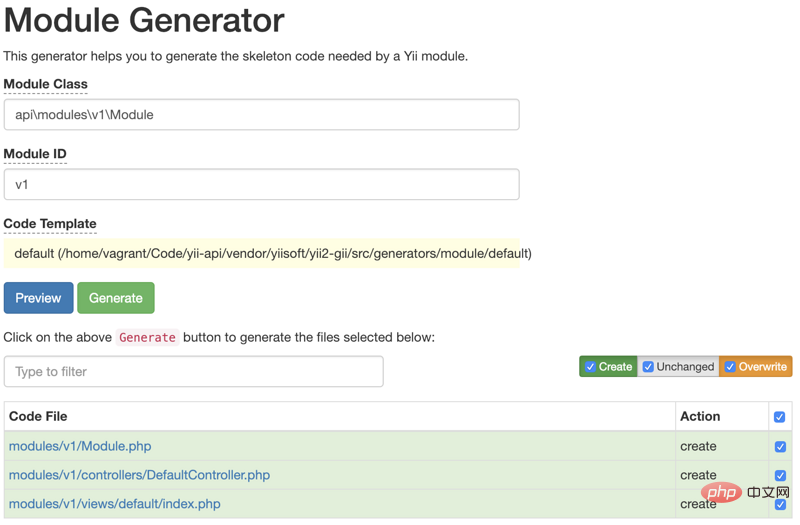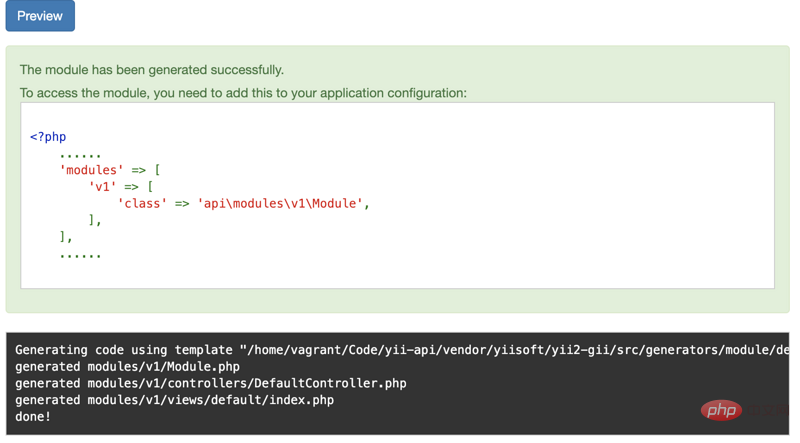 Backend Development
Backend Development
 PHP Tutorial
PHP Tutorial
 Introduction to version control of Yii2.0 RESTful API (code example)
Introduction to version control of Yii2.0 RESTful API (code example)
Introduction to version control of Yii2.0 RESTful API (code example)
This article brings you an introduction to the version control of Yii2.0 RESTful API (code examples). It has certain reference value. Friends in need can refer to it. I hope it will be helpful to you.
I have written two articles before about how to build Yii2.0 RESTful API, as well as authentication and other processing, but they did not involve version management. Today I will talk about how to implement version management.
Let’s just start from scratch and build it step by step. However, some concepts and usage will not be explained one by one in this article. You can refer to the first Yii2.0 RESTful API basic configuration tutorial for configuration
Install Yii2.0
Install via Composer
This is the preferred method to install Yii2.0. If you don't have Composer installed yet, you can follow the instructions here to install it.
After installing Composer, run the following command to install the Composer Asset plug-in:
composer global require "fxp/composer-asset-plugin:^1.2.0"
To install the advanced application template, run the following command:
composer create-project yiisoft/yii2-app-advanced yii-api 2.0.14
Copy backend directory, named api
Open api\config\main.php and modify the id, controllerNamespace:
return [ 'id' => 'app-api', 'basePath' => dirname(__DIR__), 'controllerNamespace' => 'api\controllers', ]
Initialize the advanced template
Before initializing, you may wish to read this article
cd advanced php init
Open common\config\main.php to enable url routing beautification rules
'urlManager' => [ 'enablePrettyUrl' => true, 'showScriptName' => false, 'rules' => [ ], ],
Open common\config\bootstrap.php and add the following alias
Yii::setAlias('@api', dirname(dirname(__DIR__)) . '/api');ok, the above work is ready, let’s get to the point,
For more information about the version, you can refer to the authoritative guide, but I won’t explain too much here (PS: Mainly, I don’t know how to...)
My understanding:
You can understand the versions of Yii2 as different modules. Each version is a new module, such as the common v1, v2, etc.
Building the module
Regarding how to generate the module, we can use GII to generate it.
Configuring GII
Open the api/config/main-local.php file and modify it as follows:
if (!YII_ENV_TEST) {
// configuration adjustments for 'dev' environment
$config['bootstrap'][] = 'debug';
$config['modules']['debug'] = [
'class' => 'yii\debug\Module',
];
$config['bootstrap'][] = 'gii';
$config['modules']['gii'] = [
'class' => 'yii\gii\Module',
'allowedIPs' => ['127.0.0.1', '*']
];
}Because I am using Homestead, access to GII is not allowed by default, so I have to add 'allowedIPs' => ; ['127.0.0.1', '*'], otherwise Forbidden (#403) will appear. You can configure it according to your own needs, or do not configure it
Generate Modules
Browse Enter http://your host/gii into the generator, you can see the Module Generator, click Start
Modules Class and enter: api\modules\v1\Module
Module ID and enter v1, (Generally it will be entered automatically)
Click Preview


'modules' => [ 'v1'=>[ 'class'=>'api\modules\v1\Module', ], ],
'urlManager' => [ 'enablePrettyUrl' => true, 'enableStrictParsing' => true, 'showScriptName' => false, 'rules' => [ ['class' => 'yii\rest\UrlRule', 'controller' => 'v1/default', 'extraPatterns'=>[ 'GET index'=>'index', ], ], ], ],
http://localhost/v1/defaults
. In fact, the defaults we just visited These two files are the same as traditional web projects. The controller renders the view
Create a new UserController under modules\v1\controllers
<?php namespace api\modules\v1\controllers;
use yii\rest\Controller;
/**
* User controller for the `v1` module
*/
class UserController extends Controller
{
/**
* @return string
*/
public function actionIndex()
{
return 'this is v1/user';
}
}'urlManager' => [ 'enablePrettyUrl' => true, 'enableStrictParsing' => true, 'showScriptName' => false, 'rules' => [ ['class' => 'yii\rest\UrlRule', 'controller' => 'v1/default', 'extraPatterns'=>[ 'GET index'=>'index', ], ], ['class' => 'yii\rest\UrlRule', 'controller' => 'v1/user', 'extraPatterns'=>[ 'GET index'=>'index', ], ], ], ],
http://localhost/v1/users/index
Formatted response
Modify api/config/main. php add response'response' => [
'class' => 'yii\web\Response',
'on beforeSend' => function ($event) {
$response = $event->sender;
$response->data = [
'success' => $response->isSuccessful,
'code' => $response->getStatusCode(),
'message' => $response->statusText,
'data' => $response->data,
];
$response->statusCode = 200;
},
],in the components array
The above is the detailed content of Introduction to version control of Yii2.0 RESTful API (code example). For more information, please follow other related articles on the PHP Chinese website!

Hot AI Tools

Undresser.AI Undress
AI-powered app for creating realistic nude photos

AI Clothes Remover
Online AI tool for removing clothes from photos.

Undress AI Tool
Undress images for free

Clothoff.io
AI clothes remover

Video Face Swap
Swap faces in any video effortlessly with our completely free AI face swap tool!

Hot Article

Hot Tools

Notepad++7.3.1
Easy-to-use and free code editor

SublimeText3 Chinese version
Chinese version, very easy to use

Zend Studio 13.0.1
Powerful PHP integrated development environment

Dreamweaver CS6
Visual web development tools

SublimeText3 Mac version
God-level code editing software (SublimeText3)

Hot Topics
 Explain JSON Web Tokens (JWT) and their use case in PHP APIs.
Apr 05, 2025 am 12:04 AM
Explain JSON Web Tokens (JWT) and their use case in PHP APIs.
Apr 05, 2025 am 12:04 AM
JWT is an open standard based on JSON, used to securely transmit information between parties, mainly for identity authentication and information exchange. 1. JWT consists of three parts: Header, Payload and Signature. 2. The working principle of JWT includes three steps: generating JWT, verifying JWT and parsing Payload. 3. When using JWT for authentication in PHP, JWT can be generated and verified, and user role and permission information can be included in advanced usage. 4. Common errors include signature verification failure, token expiration, and payload oversized. Debugging skills include using debugging tools and logging. 5. Performance optimization and best practices include using appropriate signature algorithms, setting validity periods reasonably,
 Explain late static binding in PHP (static::).
Apr 03, 2025 am 12:04 AM
Explain late static binding in PHP (static::).
Apr 03, 2025 am 12:04 AM
Static binding (static::) implements late static binding (LSB) in PHP, allowing calling classes to be referenced in static contexts rather than defining classes. 1) The parsing process is performed at runtime, 2) Look up the call class in the inheritance relationship, 3) It may bring performance overhead.
 PHP Program to Count Vowels in a String
Feb 07, 2025 pm 12:12 PM
PHP Program to Count Vowels in a String
Feb 07, 2025 pm 12:12 PM
A string is a sequence of characters, including letters, numbers, and symbols. This tutorial will learn how to calculate the number of vowels in a given string in PHP using different methods. The vowels in English are a, e, i, o, u, and they can be uppercase or lowercase. What is a vowel? Vowels are alphabetic characters that represent a specific pronunciation. There are five vowels in English, including uppercase and lowercase: a, e, i, o, u Example 1 Input: String = "Tutorialspoint" Output: 6 explain The vowels in the string "Tutorialspoint" are u, o, i, a, o, i. There are 6 yuan in total
 How do you parse and process HTML/XML in PHP?
Feb 07, 2025 am 11:57 AM
How do you parse and process HTML/XML in PHP?
Feb 07, 2025 am 11:57 AM
This tutorial demonstrates how to efficiently process XML documents using PHP. XML (eXtensible Markup Language) is a versatile text-based markup language designed for both human readability and machine parsing. It's commonly used for data storage an
 What are PHP magic methods (__construct, __destruct, __call, __get, __set, etc.) and provide use cases?
Apr 03, 2025 am 12:03 AM
What are PHP magic methods (__construct, __destruct, __call, __get, __set, etc.) and provide use cases?
Apr 03, 2025 am 12:03 AM
What are the magic methods of PHP? PHP's magic methods include: 1.\_\_construct, used to initialize objects; 2.\_\_destruct, used to clean up resources; 3.\_\_call, handle non-existent method calls; 4.\_\_get, implement dynamic attribute access; 5.\_\_set, implement dynamic attribute settings. These methods are automatically called in certain situations, improving code flexibility and efficiency.
 PHP and Python: Comparing Two Popular Programming Languages
Apr 14, 2025 am 12:13 AM
PHP and Python: Comparing Two Popular Programming Languages
Apr 14, 2025 am 12:13 AM
PHP and Python each have their own advantages, and choose according to project requirements. 1.PHP is suitable for web development, especially for rapid development and maintenance of websites. 2. Python is suitable for data science, machine learning and artificial intelligence, with concise syntax and suitable for beginners.
 PHP: A Key Language for Web Development
Apr 13, 2025 am 12:08 AM
PHP: A Key Language for Web Development
Apr 13, 2025 am 12:08 AM
PHP is a scripting language widely used on the server side, especially suitable for web development. 1.PHP can embed HTML, process HTTP requests and responses, and supports a variety of databases. 2.PHP is used to generate dynamic web content, process form data, access databases, etc., with strong community support and open source resources. 3. PHP is an interpreted language, and the execution process includes lexical analysis, grammatical analysis, compilation and execution. 4.PHP can be combined with MySQL for advanced applications such as user registration systems. 5. When debugging PHP, you can use functions such as error_reporting() and var_dump(). 6. Optimize PHP code to use caching mechanisms, optimize database queries and use built-in functions. 7
 Explain the match expression (PHP 8 ) and how it differs from switch.
Apr 06, 2025 am 12:03 AM
Explain the match expression (PHP 8 ) and how it differs from switch.
Apr 06, 2025 am 12:03 AM
In PHP8, match expressions are a new control structure that returns different results based on the value of the expression. 1) It is similar to a switch statement, but returns a value instead of an execution statement block. 2) The match expression is strictly compared (===), which improves security. 3) It avoids possible break omissions in switch statements and enhances the simplicity and readability of the code.





